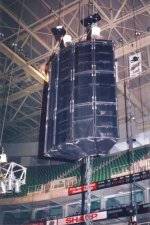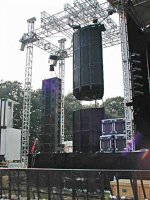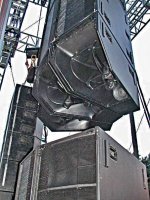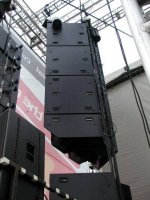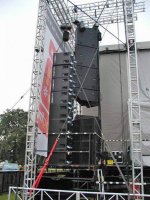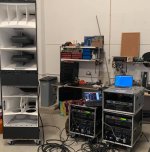Guys,
this is a question that i had since many many years back, but it was until today that i dare to ask
so, why most of the mid grade ( QSC KW series , EV ETX, JBL SRX 800's ) V2 way or 3way PA cabinets
max SPL ratings are around 135 or 136 dB's
is because the limits of physics or because the limits of the drivers for that given price ( max 2k )
as far as i know the HF driver is padded because it have much better sensitivity that then LF driver
so the LF cant cope with the HF power limit and that is why manufacturers can only achieve around 135SPL's
i saw the new MEYER Panther series that are rated at around 150dB's SPL but those are linear cabinets and i think they cost above 8k each
but what about the 2 way single point PA loudspeakers
this is a question that i had since many many years back, but it was until today that i dare to ask
so, why most of the mid grade ( QSC KW series , EV ETX, JBL SRX 800's ) V2 way or 3way PA cabinets
max SPL ratings are around 135 or 136 dB's
is because the limits of physics or because the limits of the drivers for that given price ( max 2k )
as far as i know the HF driver is padded because it have much better sensitivity that then LF driver
so the LF cant cope with the HF power limit and that is why manufacturers can only achieve around 135SPL's
i saw the new MEYER Panther series that are rated at around 150dB's SPL but those are linear cabinets and i think they cost above 8k each
but what about the 2 way single point PA loudspeakers
Yeah that is the limit of the current LF driver technology and in fact even that is stretching the truth a bit... only the best of them can produce a continuous average of more than 130dB. To do better than that requires multiple LF drivers or horn loading.
thats what i tought but was not sure and wanted to confirm.
i saw bassboss v12 that cost 3.5k but the specs are not better that an Ev etx12 , so why bassboss markup their stuff so much
i saw bassboss v12 that cost 3.5k but the specs are not better that an Ev etx12 , so why bassboss markup their stuff so much
It's a tricky subject. I wrote an article about it: https://www.prosoundweb.com/spec-wars-looking-inside-loudspeaker-spl-specifications/
After arguing with a company rep that their 1x10" line array element can't hit 136dB down to 60Hz.
FWIW, from what I can tell, BassBoss use high-end drivers, and will likely hold up much better than the EVs during heavy use.
Chris
After arguing with a company rep that their 1x10" line array element can't hit 136dB down to 60Hz.
FWIW, from what I can tell, BassBoss use high-end drivers, and will likely hold up much better than the EVs during heavy use.
Chris
so that means that on a single point loudspeaker we can only have one on each side..maybe 2 ..top of each other config (horns next to each other stacked vertically) and thats it ... if we want more spl at the dance floor we need to go with line array cabinets as the single point do not sum well in clusters cause the hf lens be too wide and cause all sorts of nasty cancellations and comb filtering. as of now i think a pair of etx10's per side will give the most bang for the buck(cabinets below 1.5k) i have seen them at 1k open box, they use FIR processing from their DC one processor according to the specs posted online. i have heard the Kw series and the etx side to side and the etx sound clearer and louder when pushthem towards limiting, to me qsc is overpriced but to each its own, this is just my personal point of view according to my subjective on the field perception.
I own or have used most of the current EV powered speaker lineup including the ETX series.
Yes and no. There are a few 3-way powered boxes that tend to be the loudest in thier lineup and there are a few non standard designs with multiple low/mids in either an MTM or MMT arrangement, look for the Ingenia iG4t and RCF NX series. But also note that comb filtering is exactly what makes a line array behave the way it does and in comparison a couple of point source splayed boxes side by side is pretty smooth... and you may need that to get decent coverage anyway so it's probably not something to get too concerned with.so that means that on a single point loudspeaker we can only have one on each side..maybe 2 ..top of each other config (horns next to each other stacked vertically) and thats it ... if we want more spl at the dance floor we need to go with line array cabinets as the single point do not sum well in clusters cause the hf lens be too wide and cause all sorts of nasty cancellations and comb filtering.
I have used most of the new EV powered boxes including the ETX and yes they are very good IMO. The original K series is badly outclassed by most modern powered speaker offerings, they did tend to get rather harsh when pushed while none of the newer powerered boxes I have used display this trait.. they just indicate limiting and stop getting any louder.as of now i think a pair of etx10's per side will give the most bang for the buck(cabinets below 1.5k) i have seen them at 1k open box, they use FIR processing from their DC one processor according to the specs posted online. i have heard the Kw series and the etx side to side and the etx sound clearer and louder when pushthem towards limiting, to me qsc is overpriced but to each its own, this is just my personal point of view according to my subjective on the field perception.
I disagree there are several alternatives to line arrays:so that means that on a single point loudspeaker we can only have one on each side..maybe 2 ..top of each other config (horns next to each other stacked vertically) and thats it ... if we want more spl at the dance floor we need to go with line array cabinets as the single point do not sum well in clusters cause the hf lens be too wide and cause all sorts of nasty cancellations and comb filtering.
1) high frequency combiners (see danley Jerico series)
2) dividing the frequency range more (many very high SPL point sources are stacks of speakers 3/4/5 way). See Void Incubus (also uses array HF).
3) various clustering techniques, the more narrow each speakers dispersion the louder it will typicaly be due to radiating into a smaller solid angle. In a cluster the woofers will mutualy couple increasing midbass SPL capability. If the system/speaker is designed well the response anomolies due to clustering are not too bad.
Check out this JBL HLA cluster:
In fact would it suprise you that some of the largest gigs of all time did not use line arrays I have attached the info I have on the community airforce system which I have been told did 100k people with no delays.
Attachments
-
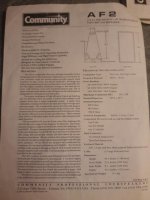 120195976_653052815639256_2016135544271539684_n.jpg53.4 KB · Views: 110
120195976_653052815639256_2016135544271539684_n.jpg53.4 KB · Views: 110 -
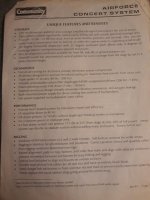 120362301_653052775639260_1310032848506877836_n.jpg83.6 KB · Views: 93
120362301_653052775639260_1310032848506877836_n.jpg83.6 KB · Views: 93 -
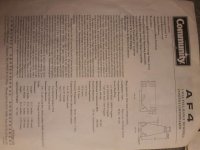 120443042_653052902305914_7673010185519577932_n.jpg58.8 KB · Views: 99
120443042_653052902305914_7673010185519577932_n.jpg58.8 KB · Views: 99 -
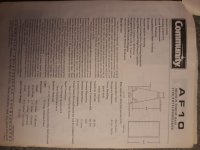 120451817_653052948972576_5931008353202649085_n.jpg61.3 KB · Views: 106
120451817_653052948972576_5931008353202649085_n.jpg61.3 KB · Views: 106 -
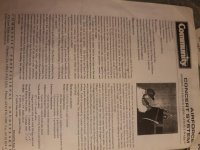 120451997_653052985639239_9007270836166849088_n.jpg75.5 KB · Views: 101
120451997_653052985639239_9007270836166849088_n.jpg75.5 KB · Views: 101 -
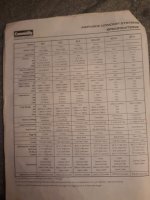 120453199_653052712305933_4093263155905260285_n.jpg51.1 KB · Views: 100
120453199_653052712305933_4093263155905260285_n.jpg51.1 KB · Views: 100 -
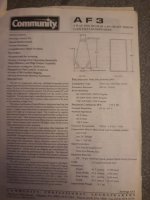 120455777_653052858972585_2230850238548615038_n.jpg47.4 KB · Views: 101
120455777_653052858972585_2230850238548615038_n.jpg47.4 KB · Views: 101 -
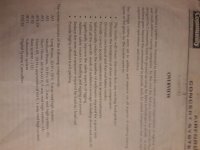 120485999_653052738972597_3952242462293773163_n.jpg44.2 KB · Views: 102
120485999_653052738972597_3952242462293773163_n.jpg44.2 KB · Views: 102
More airforce pics and the 'leviathan' horn.
Attachments
wow ,136 dbs spl continous, the "normal" max spl of most manufacturers are peak spl not rms spl, but most do not state it, just print "max spl" instead of the average continous spl, that is around 10 to 12 dbs less if i am not mistakenMore airforce pics and the 'leviathan' horn.
btw, what amps was used for the airforce and how many, i guess they have used a fleet of 18 whellers diesel generators capable of light manhattan. 😉
Theres a bit more info on the airforce on the 'speaker freakers' facebook page and this booklet with loads of info:
https://www.yumpu.com/en/document/read/6466821/large-scale-sound-reinforcement-community-airforce
https://drive.google.com/file/d/1lx_5X_Fl_ywglkUHQINQnu-YaTaU-4Ws/view?usp=sharing (as I hate broken links and suspect that yumpu thing will go down at some point)
from speaker freakers comments:
Actualy 120k people, AF1 box was never made due to HF requirment been not posible at the time, Two airforce systems where produced (not a sucessfull product) and one was for sale in UK during 2020.
Community light and sound is now owned by Biamp and they still make high SPL point source boxes however nothing of the scale of the airforce system. I terms of amps big amps of the era would have been stuff like the Crown MA5000VZ, Crest 9001 etc. Very heavy and high power consumption compared to modern amplifiers. Big systems sometimes reached the maximum current they could pull from the generator and maximum truck weight before they where limited by the drive units power handling.
There is actauly a standard based on MNOISE for max SPL in progress/recently completed:
https://m-noise.org/
https://www.yumpu.com/en/document/read/6466821/large-scale-sound-reinforcement-community-airforce
https://drive.google.com/file/d/1lx_5X_Fl_ywglkUHQINQnu-YaTaU-4Ws/view?usp=sharing (as I hate broken links and suspect that yumpu thing will go down at some point)
from speaker freakers comments:
Actualy 120k people, AF1 box was never made due to HF requirment been not posible at the time, Two airforce systems where produced (not a sucessfull product) and one was for sale in UK during 2020.
Community light and sound is now owned by Biamp and they still make high SPL point source boxes however nothing of the scale of the airforce system. I terms of amps big amps of the era would have been stuff like the Crown MA5000VZ, Crest 9001 etc. Very heavy and high power consumption compared to modern amplifiers. Big systems sometimes reached the maximum current they could pull from the generator and maximum truck weight before they where limited by the drive units power handling.
There is actauly a standard based on MNOISE for max SPL in progress/recently completed:
https://m-noise.org/
Lambda labs also do a high power point source cluster system:
https://www.lambda-labs.com/en/products/qx-3
it gets out quite a bit judging from lambda labs FB page so I'm suprised their website hasn't more info.
"I'm working with a very similar concept system now, one that has solved the HF problem (16 1" drivers and 32 2" drivers in one box)" I assume thats cramed into the top horn somehow which is quite mad!
https://www.lambda-labs.com/en/products/qx-3
it gets out quite a bit judging from lambda labs FB page so I'm suprised their website hasn't more info.
"I'm working with a very similar concept system now, one that has solved the HF problem (16 1" drivers and 32 2" drivers in one box)" I assume thats cramed into the top horn somehow which is quite mad!
Attachments
Ohh ! super nice info there Kipman
Thanks for sharing mate.
and the lambda speakers are unbelievable , example is the 18" Sub horn
"Rigid braced construction of special 15mm lightweight-wood" only 138lbs !!!
i bet they cost 8k+

Thanks for sharing mate.
and the lambda speakers are unbelievable , example is the 18" Sub horn
"Rigid braced construction of special 15mm lightweight-wood" only 138lbs !!!
i bet they cost 8k+
Last edited:
just downloaded the M-noise wave, sounds like pink noise with some crackling file on top of it 😀
you can use a dynamic mic to perform the M-noise testing to get round measurement mic SPL limitations allowing you to do the test close mic'ed. The main issue I have is that my speakers M-noise SPL is probobly too high for domestic testing....just downloaded the M-noise wave, sounds like pink noise with some crackling file on top of it 😀
You can make a cal file for your dynamic microphone by comparison with the results obtained with a measurement mic.
True, but with dynamic mics often struggling above 10kHz and below 50Hz (requiring large compensations and, in the HF, finnicky positioning), I'd opt for a large-diaphragm condenser. It's often possible to rent those from nearby studios, and the good ones will take >150dB without complaining.
Chris
Chris
It’s essentially a Unity Horn arrangement for the 1” and 2” elements.Lambda labs also do a high power point source cluster system:
https://www.lambda-labs.com/en/products/qx-3
it gets out quite a bit judging from lambda labs FB page so I'm suprised their website hasn't more info.
"I'm working with a very similar concept system now, one that has solved the HF problem (16 1" drivers and 32 2" drivers in one box)" I assume thats cramed into the top horn somehow which is quite mad!
how does this work for the 1" elements?It’s essentially a Unity Horn arrangement for the 1” and 2” elements.
- Home
- Live Sound
- PA Systems
- SPL limit for 2 way or 3way single point loudspeakers question
